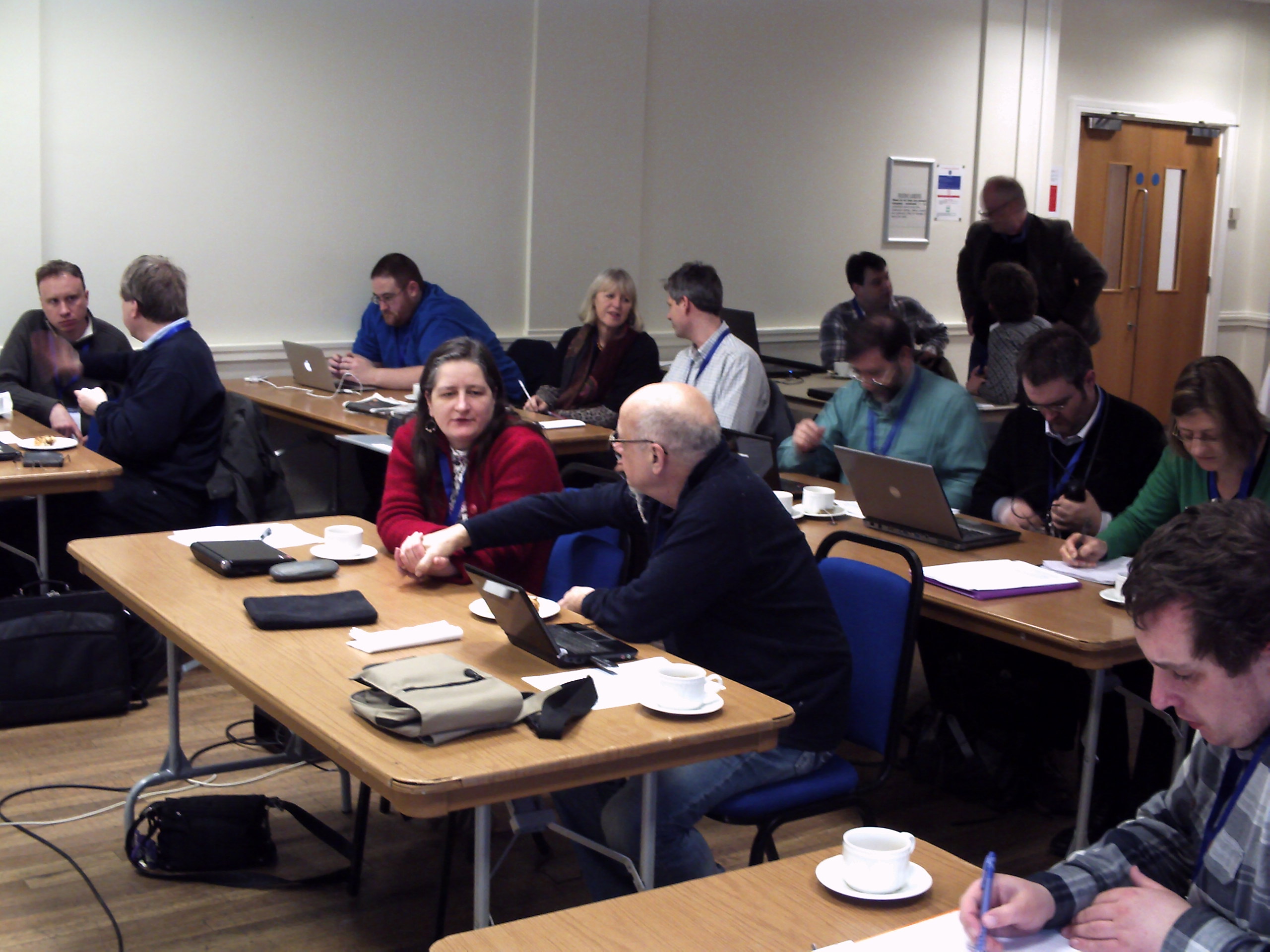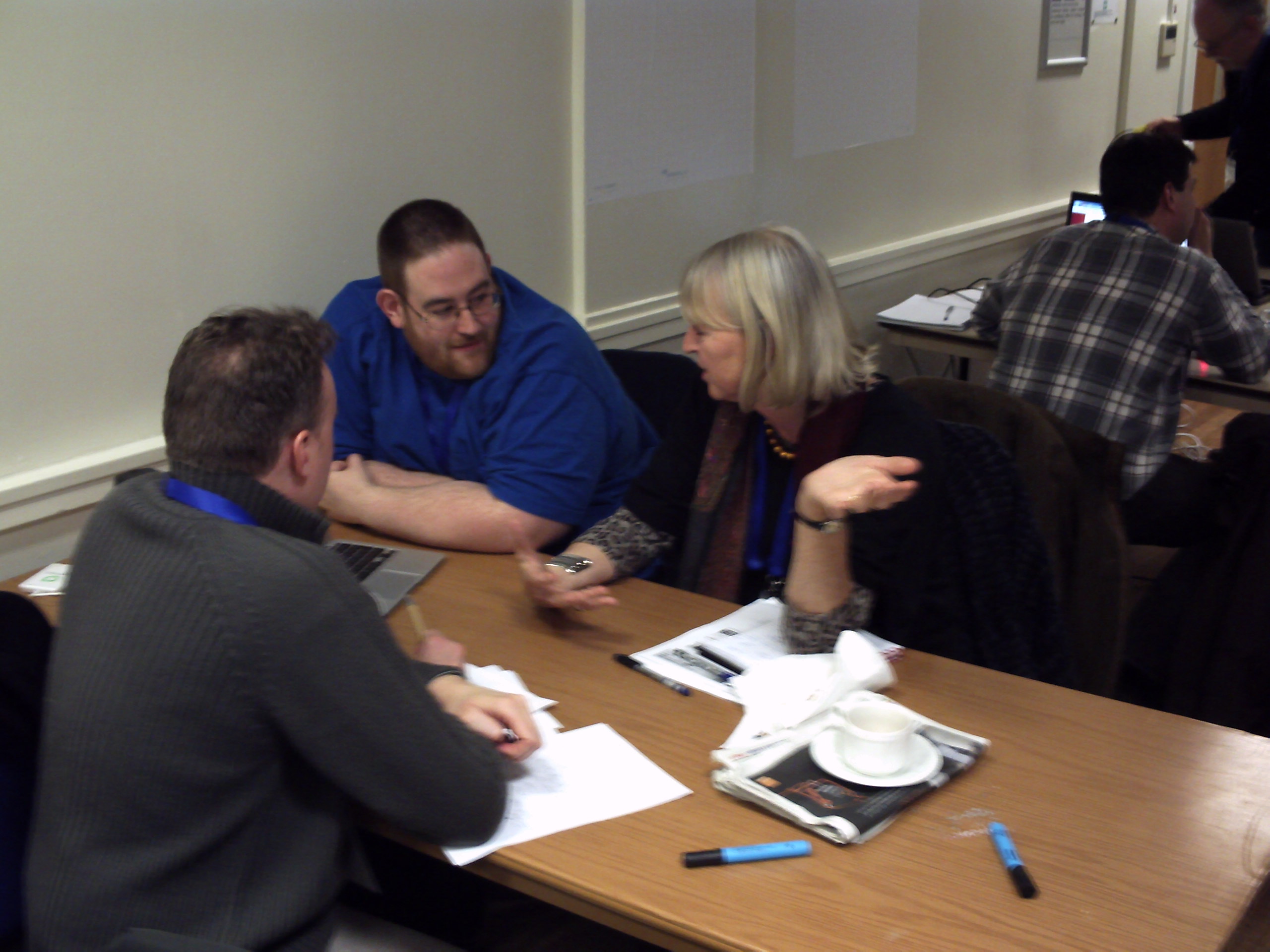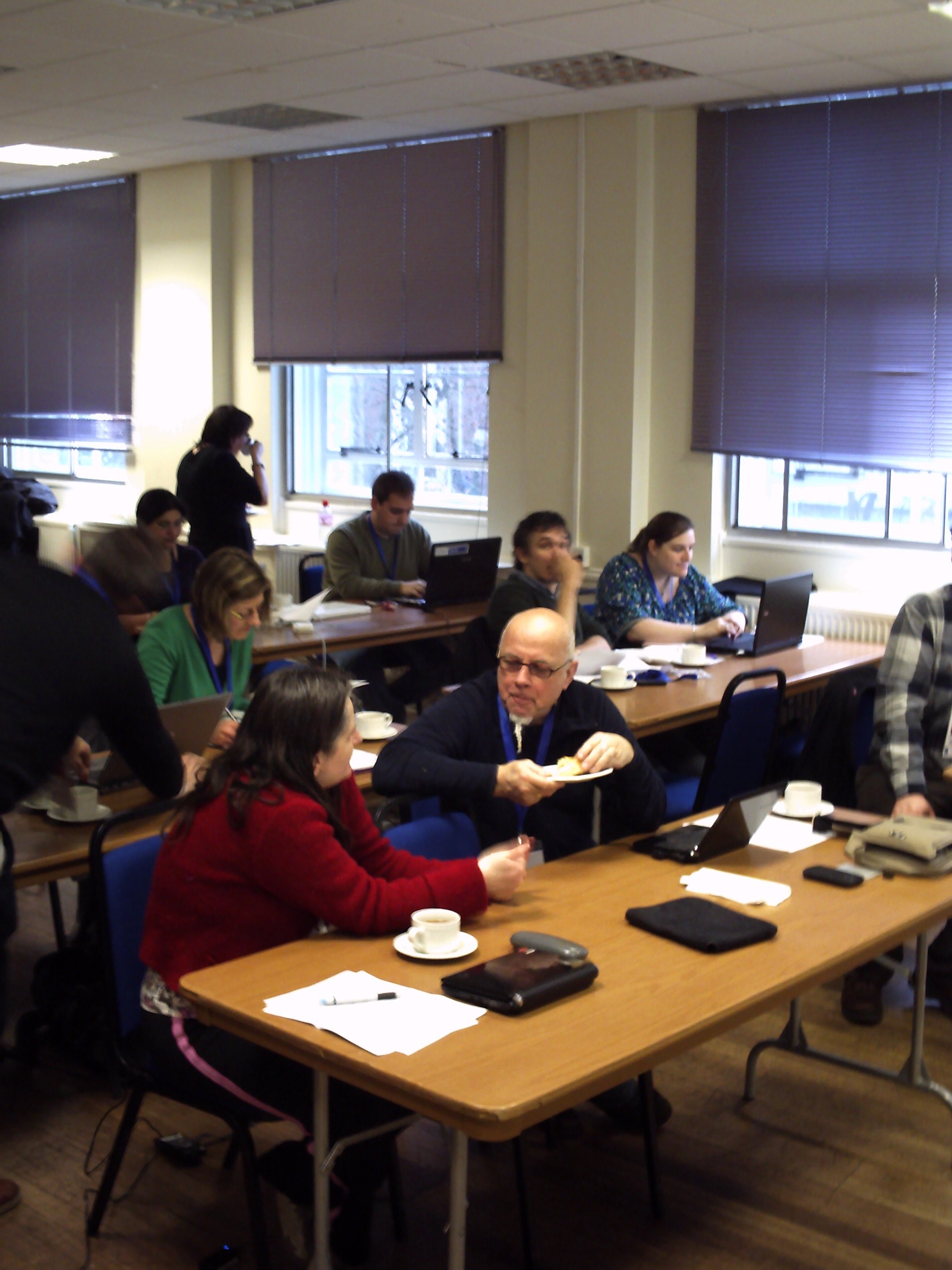-
Picture This! (hack day at Dev8D+)
Posted on March 1st, 2011 No commentsThe Picture This! event on image metadata was held at Dev8D+ on 15 February 2011 at the University of London Union (ULU) in Bloomsbury, London. It led into the Picture This! Developer Challenge at Dev8D on 16/17 February 2011.
The morning began with a brief, practical introduction to application profiles for image metadata by Talat Chaudhri of the Application Profiles Support Project, aimed at getting the attendees to think about the kinds of metadata solutions required for the specific problems that face them in dealing with images within the public-facing systems that they run in their institutions. He invited the attendees to think about the sorts of metadata and the kinds of relationships between images as related web resources that might be required in these systems.
The attendees then delivered some lightning talks, outlining the sorts of problem spaces that they are seeking to deal with in order to deliver image resources more successfully to users. Most of these centred around EXIF, IPTC, as well as ISO 19139 for geospatial metadata. Other metadata standards that were mentioned included NISO MIX and VRA. The talks were focussed on a range of issues including embedding image metadata within images, extracting metadata from images on services such as Flickr using the relevant API, auto-generation and enrichment of metadata, and visual surfacing of copyright and other information for users from embedded metadata within images. There was surprisingly little interest in managing relationships between images, for example where various different types of post-processing of a particular image has resulted in multiple related images that stem from the same original. It was also quite notable that comparatively little attention was given to subject metadata by attendees at the event. Holding the event at an event for developers may explain the relative lack of interest in these areas, which have been more significant issues at meetings of the Metadata Forum.
After lunch, the attendees formed into groups that included both metadata practitioners and developers, to address the issues raised by the lightning talks. They later delivered pitches based on these ideas, several of which fed into the Picture This! Developer Challenge at Dev8D. In addition to the attendees themselves, a number of additional developers who attended Dev8D+ offered their advice and collaboration, and dropped in and out of the afternoon session. This sharing of expertise highlighted the value of the collaborative approach taken at Dev8D, as well as directly helping practitioners with the problems that they had outlined during the morning session. Particular mention should be made of Ben O’ Steen and Ben Charlton for the considerable help that they gave to developers and practitioners throughout the day.
Ben O’ Steen talks about Picture This! and Dev8DAs part of theDev8D Developer Challenge, the Picture This! event offered prizes of Amazon vouchers for first and second prize for those who came up with the most innovative and practical solutions to identified problems using image metadata.
The first prize of a £50 Amazon voucher went to Robert Baker and Roger Greenhaigh for their work in extracting embedding copyright information from images and dynamically modifying images to include a banner including a logo displaying the licence, e.g. the specific type of Creative Commons licence, and the copyright holder. The judges felt that this relatively simple but highly effective idea again had enormous potential within the UK HE sector, not least as a time-saving device with instant visual impact that could be used widely by anybody wanting to know whether or not and how they could re-use a particular image.
Rober Baker and Roger Greenhaigh’s Entry for the Developer ChallengeThe second prize of a £25 Amazon voucher went to Bharti Gupta for her work in embedding geospatial image metadata within map images, for example climate data, an idea that has enormous potential for re-use within the UK HE sector. By embedding the metadata in this way, the problem of managing images and metadata separately is removed and machine processing and transmission of map images over the web is significantly enriched without the need for metadata harvesting.
“Before”: Bharti Gupta talks about Picture This!
“After”: Bharti Gupta’s Entry for the Developer ChallengeIanthe Hind and Scott Renton worked on enriching image metadata using a range of techniques, the most ambitious of which was image recognition. Ianthe’s work on this challenge at Dev8D deserves special mention for the huge effort and wide range of technologies that she investigated for auto-generation of metadata. She showed that commonly available image recognition software is not yet capable of delivering the functionality that developers need to be able to make use of existing rich metadata on the web to describe new images of known objects, places or landmarks, which would avoid the need for constant duplication and time-consuming repetitious metadata entry.
“Before”: Ianthe Hind talks about Picture This!
“After”: Ianthe Hind’s Entry for the Developer ChallengeThe organisers of the event intend to follow up on and document these outputs, and ensure that they feed back into future meetings of the Metadata Forum. The day was highly successful, the attendees were enthusiastic and motivated, and the Dev8D event format was at its best in bringing practitioners with practical problems together with developers to address real, tractable problems and produce immediate solutions and demonstrations to solve them.
application profiles application profiles, automated metadata generation, Ben Charlton, Ben O 'Steen, Bharti Gupta, Creative Commons, Dev8D+, Developer Challenge, developers, EXIF, Flickr, Flickr API, geospatial, geospatial metadata, image recognition, images, Images Application Profile, IPTC, ISO 19139, metadata, Metadata Forum, NISO MIX, Picture This!, Robert Baker, Roger Greenhaigh, VRA -
Picture This! (hack day)
Posted on January 31st, 2011 No commentsThe AP Support project and the Metadata Forum will be holding an event at Dev8D+ on 15 February (the day before Dev8D, 16-17 February), to bring practitioners who work in services dealing with images and image metadata together with developers to build practical solutions to their problems!
There will be prizes as part of the Dev8D Developer Challenge. More details can be found here on the Dev8D wiki.
-
User testing for SWAP
Posted on April 29th, 2009 3 commentsOn Monday 27 July, the first trial of methods for user testing for SWAP were conducted at UKOLN. This was very much an internal “dry run”, the success of which leaves us in a strong position to take every opportunity to repeat the exercise more widely within the repositories community.
In collaboration with the IEMSR and IE Demonstrator projects, which also have an interest in developing and implementing application profiles in repositories, we are very interested in developing methodologies for the evaluation of the Dublin Core Application Profiles (DCAPs) funded by JISC. Of these, SWAP has the best developed online presence and content in institutional repositories, as well as a strong and developed user community focussed on developing Open Access content on the Web.
Our current work is therefore focussed on SWAP in the first instance, but we naturally intend to develop the process of practical user testing for the other DCAPs. We are of course aware that the needs of different resource types and repository communities will differ very widely. This is the reason that we are interested in practical user testing within those communities, to ensure that theoretical approaches to constructing application profiles actually fill the needs and requirements than underpin the development of such content in repositories and other related services on the Web.
In many ways, it is fair to say that SWAP is the “lowest hanging fruit” for this endeavour, but the impact of getting application profiles right for such a large and growing proportion of repository content should not be underestimated. Being largely textual resources, scholarly works are likely to be an area where significant lessons can be learnt for other resource types with more specific constraints and requirements. It is intended that we conduct user testing of several other DCAPs during the summer of 2009, if possible, following initial work on SWAP.
It is perhaps worth remembering that developments in repository technology have come a long way since SWAP was first developed, the example of which the other DCAPs have tended to follow, especially in the matter of using the FRBR structure. It is by no means certain that this is the only way, or the best way, to create relationships in so-called complex objects, which is to say sets of resources that relate to each other as versions. In particular, OAI-ORE is an exciting development that may provide an alternative, although its relevance for this purpose needs to be carefully evaluated and compared to existing approaches and technologies. It will not do to simply adopt the newest, coolest approach without a careful analysis of how the needs of users relate to the functionality that is presently available. If these do not correlate well within the software contexts currently in use in the community, the application profiles will fail accordingly.
It has become obvious that implementation of the DCAPs has been slow. In the case of SWAP, which has been around the longest, that lag has become a profound apathy towards efforts to implement the application profile widely in repositories. It is not even clear how best this should be done, as neither methods nor benefits have been convincingly demonstrated. It would be a great shame if the investment of expertise in improving the metadata vocabulary were wasted because the structure has not been successfully integrated into repositories. This mismatch must be understood and resolved if the situation is to be turned round and the expected gains of SWAP and the other DCAPs are to be realised.
There are a variety of technological approaches to application profiles that will need careful study, once the user testing brings a better understanding of how users need to relate particular types of resources together in repositories. These may include the Description Set Profile approach, traditional XML with XML Schema and OAI-ORE. But more importantly, it must be shown beyond doubt how the DCAPs fit the applications that users need them for, and which changes may be required, before software developers will have the motivation to address those needs by implementing the DCAPs in the major repository platforms.
-
Welcome to the AP Support project blog
Posted on March 12th, 2009 No commentsAt present we are working on practical evaluation and user testing of SWAP, the first and most fully developed of the DCAPs funded by JISC. The aim of this work is to enable us to report on how well SWAP fits the real needs of repository managers in their day-to-day work. On this basis, we intend to organise further practical events, both for repository managers and for repository platform developers. The hope is to provide an impetus for SWAP to be supported by the major repository platforms in an appropriate form. This feedback should provide a sound basis to continue the development cycle of SWAP and improve it over time.
We are not forgetting, however, the needs of the other resource types for which DCAPs have been developed, and the process is intended to be an iterative one, learning from the experience of SWAP in the first instance and inviting domain specialists for each resource type to help adapt the process for the needs of the section of the repository community involved with that particular resource. We invite those user communities and specialists to engage with us in the same process as outlined for SWAP above.
Web resources have living, changing needs and user communities, so we believe that their application profiles should reflect this. Obviously, there is a balance to be struck between developing and maintaining useful standards that can be relied upon, and meeting these changing requirements. The only way to do this properly is to use inclusive methods, consulting domain specialists and real users as much as possible.









